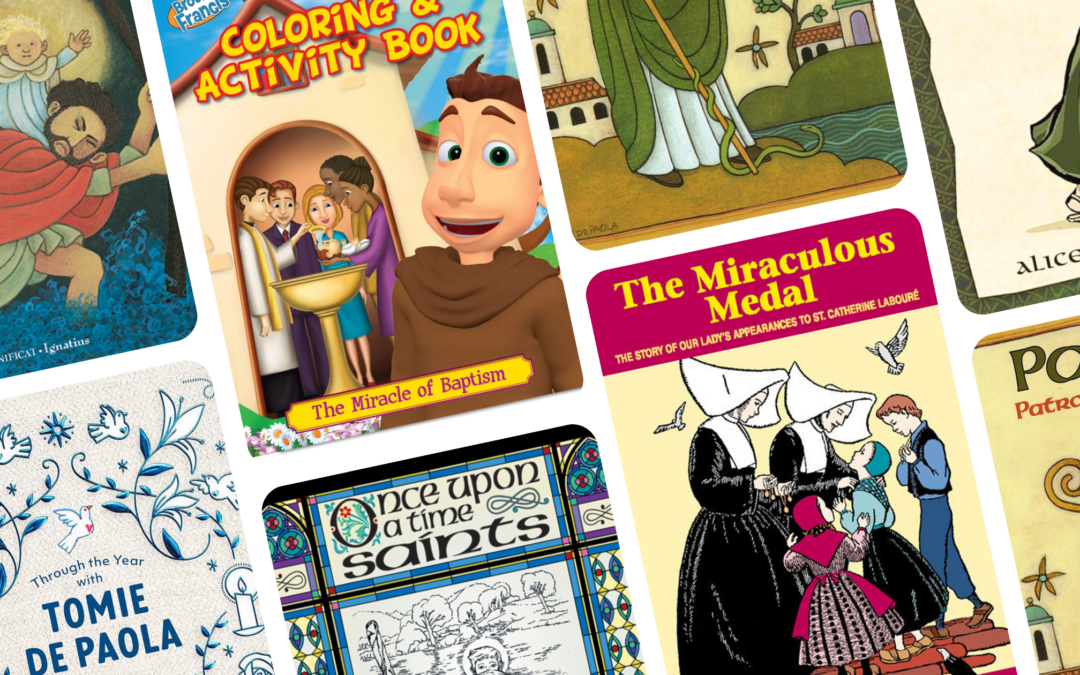Saintly Heroes: How to Make Saint Stories Real for Children
A Catholic Homeschool Guide to Inspiring Young Hearts
We all know that children love stories. Yet, anyone who has listened to a youngster recount a dream that has an uncanny resemblance to the plot of The Lion, the Witch, and the Wardrobe will agree that the incredible imagination of children has no problem assimilating and repurposing what they have learned from their surroundings.
This special impressionability is incredibly beautiful and downright cute. However, it is also one of the reasons that we worry so much about the material our children are exposed to.
Who will our children pick for their heroes, and who will feature in the stories they tell? As Catholics, we hope they will pick the saints! These are, after all, the heroic men and women that the Church holds up for our imitation.
This article is the first in a series designed to help you think about how you can present Catholic saints to your young children in a way that will not only be fun and informative but will also resonate down the years into a fruitful spiritual life.
Who Are These Saints?
You can’t teach what you don’t know. To take the inverse of St. Paul’s words, you cannot pass on what you have not received. So many of us wish that we had received a fully Catholic education ourselves and that feasts like Michaelmas, Lammas, and Lady Day were a natural part of our annual rhythms. Or, perhaps we just wish we knew what all these strange words mean!
Regardless of your knowledge of Catholic trivia, confronting entire calendars full of saints whose names are entirely unfamiliar to you can often feel overwhelming. (And perhaps also challenging to pronounce… St. Symphorosa, for a start, and St. Caoilfionn…) I remember the awful moment when I first moved to Ireland and realized that there is an entirely separate Irish calendar with an Irish saint (or two or three!) for every day of the year. The fact that the seemingly inexhaustible Butler’s Lives of the Saints was only a drop in the bucket of the saints that we know of really got to me and inspired me to look around my new surroundings with deeper historical attention.
All this to say that the first step in incorporating a rich understanding of the saints and their ways into your child’s life is to start with some basic information about who the saints really were, what they did, and why this made them saints.
Saint Stories for Children
There can be no better way to encounter the saints than through stories!
Start with books that are both factually accurate and well written—the saints can come alive for children at any age through a good storyteller! There can be a strange reluctance to demand that religious books for children also be good literature—it can feel not quite the done thing to criticize any piece of art that takes a religious subject.
Yet, I would argue that it is of the utmost importance that the books through which your children first encounter the heroes of their faith let them see the beauty of the Christian life through the beauty of the story. Because it is so important that children receive a positive impression of the saints we want them to hold up as models, we must ensure that their introduction is pleasant and instructive.
I always think that a good measure of a children’s book is whether you would read it yourself. I find it challenging to read biographies of “dry, dull” saints that diminish the saint’s spirit of joy in Christ. So, I don’t see why I should inflict similar dullness on the children under my charge. Of course, people’s tastes differ in what counts as dull. However, if you are the one reading to or with your child, your enthusiasm will materially affect your ability to communicate a love of the saintly life!
Where to Start?
Fortunately, there are hundreds if not thousands of good and interesting saint books for children available all over the world. Unfortunately, this makes a comprehensive list impossible.
To get you started, I’ll mention and link a few of my own personal favorites, most of which I encountered as a Catholic homeschooled kid myself. I’m trusting my past self to have only remembered the good ones!
Bear in mind that you should still always read before your child to make sure the books you provide are what he or she needs and can handle. Even though all saint stories have a happy ending, they can sometimes feature sinners and persecutions.
There are a few things to look for when finding the right books for your family.
1. Beautiful Illustrations
A key factor in selecting a saint story that you and your child can love together is to find one with beautiful illustrations that will capture the imagination.
Speaking from experience, some of the best stories I remember were accompanied by beautiful images, such as the Treasure Box series, which gave me a love of St. Therese that prepared me to later enjoy her Story of a Soul.
The Once Upon a Time Saints series also remains firmly lodged in my memory for its beautiful and detailed illustrations as well as captivating stories. (These books are also fantastic for All Saints Day parties, featuring real winners like St. Hedwig, St. Alice, and St. Hubert.)
Another excellent option is the work of popular children’s book writer and illustrator Tomie dePaola (you may know him from Strega Nona), who brings saints like St. Patrick and St. Christopher to life in his engaging books, including Through the Year, republished by Ignatius Press.
Equally delightful, the St. Joseph Picture Books set offers endless hours of amusement, and it’s never a bad idea to put some of these colorful books into the Mass bag. You might want to try a larger compilation for a bigger single book to page through.
2. Read-Aloud Potential
Engagement with saint stories, like any other stories for younger children, often depends on the parent or teacher’s willingness to enact silly voices and dramatic monologues. These stories offer potential!
For a quick bedtime story, you might try something themed, like Twenty Tales of Irish Saints by Alice Curtayne. When you’re not sure what you’re in the mood for, nothing beats one of the many compilations of short stories, like The Book of Saints and Heroes by Andrew Lang or The Storybook of Saints by Elizabeth Pham—there are so many, you can pick whatever your favorite is!
Even for those children who want a more interactive story approach, saint stories do not disappoint—you can try reading alongside your child while he or she colors the illustrations in a coloring book series. (Try Windeatt and Harmon’s or one of the many others available.)
3. Independent Reading for Growth
Introducing your child to saint stories, if successful, should blossom into the child reading more on his or her own. We all want to learn more about our heroes, and we might not all be willing to wait around for Mom or Dad to be available for storytime.
When I was able to read on my own, the over twenty books written by Mary Fabyan Windeatt were perfect, and I never appreciated my own name so much as when I read her account of St. Catherine Laboure. Then, as an adult, I was fortunate enough to pray at the chapel where Our Lady appeared to St. Catherine in Paris. I was pleased to find that all my expectations from Windeatt’s story matched the beautiful reality. When I was older again, Louis de Wohl was waiting in the wings with more exciting saint stories.
The key to allowing your child to read saint stories as they grow is to expand your library of saint books slightly ahead of your child’s current reading level—you want them to have two books always in reach, one that is easy to read and one that is a challenge. (This is a whole topic in itself, so I may need to write another article about it.)
Audiobooks For the Whole Family
Another fabulous way to introduce your children to the saints (especially if they are not yet able to read independently or if, like almost every homeschool family, you are currently carschooling) is through audiobooks.
Here again, there are many produced within the Catholic community, including some that are dramatic re-enactments as well as more traditional read-aloud stories, like the Life of St. Francis written by St. Bonaventure. (Even Audible has a few gems if you search their Catholic section.)
If you’re looking for something free but still amazing, try a podcast! You can even find some Catholic saint podcasts for kids online, though of course you will have to supervise your young children any time they access web-based content. The Merry Beggars also has a lot to choose from, featuring saint stories alongside other shows. On another note, the Augustine Institute runs a Catholic Saints podcast, which, though not designed for kids, is an amazing whole-family resource.
There is a lot out there if you’re not afraid to look!
Loving the Saints
This article is only the first in our series about the saints because learning about these holy men and women is the first step to loving them and imitating their example.
A goal of loving imitation should guide all our learning about the saints, even from the youngest ages, so don’t feel the need to treat saint stories as a formal subject. You probably didn’t need to convince your kids to imitate their favorite movie characters, and with the right mixture of learning, luck, and divine grace, your kids just might be quoting their patron saints next!
What are your thoughts or questions on this topic? You can join other Catholic homeschooling parents at our Homeschool Connections Community or our Facebook group to continue the discussion!
Note: This article contains affiliate links.






